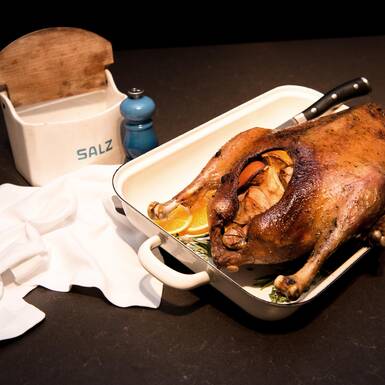- Cuisine
Maundy Thursday herb soup
Wherever the warming rays of the sun have started to melt away the snow, the first fresh herbs are already beginning to sprout from the ground. After a snowy winter, nature is reawakening with a new zest for life.
With the rising temperatures in the spring, I also start to crave fresh, healthy greens. And for that, I’ve got just the right recipe for you — and it’s one with a long tradition. For hundreds of years, Maundy Thursday — that’s the Thursday before Easter — has marked the preparation of our “nine-herb soup”. Long before tourists started flocking to Saalbach Hinterglemm, this soup has been cooked to give people their strength back after a long, hard winter. As the name suggests, this traditional soup is based on nine different wild herbs. Which exact herbs should be used isn’t strictly defined and varies from region to region. Just reach for the edible herbs that you can find in between your front door and your garden gate, on the meadows and on the edges of the forests.
Why nine?
Among the Celts, as well as the old Germanic tribes, certain numbers were believed to possess special qualities. According to old custom, this soup requires three times three “magical herbs” in order for the full power of the spring herbs to manifest. I would like to introduce you to some of the young, wild herbs that you can find in the Glemmtal valley and elsewhere, too.
1. Ground elder
Ground elder is preceded by its reputation as an unpopular garden weed. In the kitchen, however, it is a true gift. On first sight, it might be easy to confuse it with its poisonous relatives, but keeping in mind the magical number three will leave no room for doubt: Ground elder has a triangular stem — which can be felt using with your hands very easily — and trifoliate leaves, which, depending on size, further subdivide in into three smaller parts. When it comes to ground elder, it is the delicate, young leaves and stems that are used for our soup.
3. Stinging nettle
Stinging nettles grow rapidly in the spring and are readily available in large quantities. Their rich and nutritious health profile make them into real nutrient bombs that do our body good. For the soup, use only the upper, younger shoots (the top 4-5 leaves), as they contain the most nutrients.
3. Dandelion
You can spot dandelion easily by looking at its typically serrated leaves. There’s no risk in confusing this one for any other plant, for all leaves similar to it belong to the same family of plants and are all edible. Collect the smaller, younger dandelion leaves for your soup.
4. Ribwort plantain
Ribwort plantain is another herb that likes to show up in the spring. The fresh, young leaves with the noticeable veins and tip have a mild taste and a delicious aroma. When it comes to ribwort plantain, we also use the smaller, young leaves.
5. Ground ivy
Being a tasty seasoning herb, using ground ivy shouldn’t just be limited to our nine-herb soup. You may use the whole plant and all its leaves and blossoms. Since it’s very flavour-intensive, less is definitely more here.
6. Yarrow
Yarrow is a herb that should be part of any herb soup. It is a true all-rounder among the medicinal plants and has great health-promoting properties. Collect the first handful of delicate, pinnate leaves of the “eyebrow of Venus” in the spring.
7. Sorrel
Sorrel is especially popular with the kids. Its fresh flavour gives the soup its special touch. You can use the young leaves as well as the stem.
8. Lady’s mantle
Lady’s mantle isn’t just good for women — the fresh spring leaves have an invigorating effect on the whole family. It has a slightly bitter, sour, yet pleasant taste. The smaller leaves are used almost exclusively, since the aroma gets too intensive as age and size increase.
9. Deadnettle
Without its blossoms it almost looks a little like the stinging nettle. Once you touch it, however, you should notice right away that it’s actually a deadnettle, since it doesn’t “burn”. An additional and typical distinguishing feature is the tetragonal stem. Use the upper shoots for our soup.
This is just a small selection of wild herbs for your Maundy Thursday soup. Watercress, chickweed, wormwood and lovage would be equally suitable. Wild garlic would also make a perfect addition to our nine-herb soup.
Traditional Maundy Thursday soup ...
...made from nine different herbs
- 2-3 handfuls of fresh wild herbs (9 different herbs in total)
- 1 handful of colourful, edible spring blossoms (daisies, lungwort, viola or primrose)
- 30 g butter
- 1 medium-sized onion
- 2-3 potatoes, diced
- 1 ½ litre vegetable stock
- Cream or crème fraiche, if desired
- Salt, pepper, nutmeg
Finely dice the onion and sauté in butter. Then, add diced potatoes and fry briefly. Add vegetable stock and cook for around 10-15 minutes on a low flame until the potatoes are soft. Chop herbs coarsely, add to the pan and bring to a boil. Take the pot off the stove and let the soup steep for 5 minutes while covered. Finally, add a dash of cream or crème fraiche. Season with salt, pepper and nutmeg and puree with a hand blender. Before serving, garnish the soup with a few fresh blossoms.
My tip for all those who aren’t sure whether they can reliably recognise the right wild herbs: Pick the herbs that you already know for your soup. You can replace the rest with “tamed” herbs like parsley, oregano, balm, etc. So, have I gotten you hungry for some fresh, healthy spring herbs? Then give the nine-herb soup a try and sample the traditional flavour of spring in Saalbach Hinterglemm!












